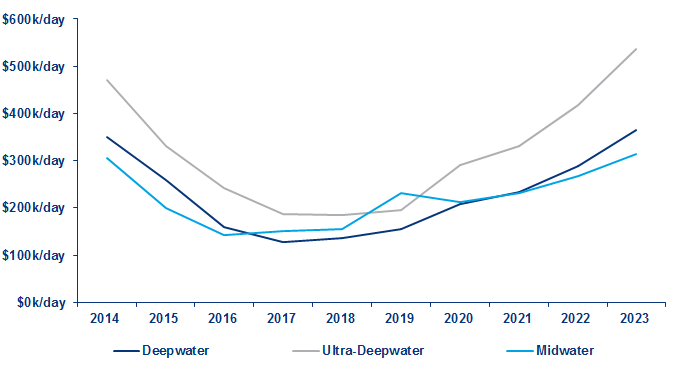3 things to consider before you buy a deepwater rig
Rising drilling activity could lead to a rig market squeeze
1 minute read
Simon Flowers
Chairman, Chief Analyst and author of The Edge

Simon Flowers
Chairman, Chief Analyst and author of The Edge
Simon is our Chief Analyst; he provides thought leadership on the trends and innovations shaping the energy industry.
View Simon Flowers's full profileIs it time to invest in the sharp end of the sector?
The collapse in upstream investment has wreaked havoc on the offshore rig market, leading to rationalisation and consolidation. Those owners left have been clinging on by their fingertips. The number of rigs operating under contract is still at slump levels of under 200, down by one-third from the peak.
Prophets of doom have argued that there will be no cyclical upturn this time – conventional offshore oil and gas developments, with the odd exception, have been squeezed out of the cost curve by the rise of tight oil. Yet there are signs of recovery that might breathe life back into the sector. Leslie Cook, Principal Analyst, Supply Chain, identifies three.
1. The outlook for investment in offshore projects is looking better
The upstream industry has cut costs, leading to more new projects coming forward for FID. Development drilling accounts for around two-thirds of all offshore wells, and on some projects can be as much as half of total capital expenditure.
We think 2019 will prove to be the low point in the cycle for development drilling, and the potential upside is material. Our database tracks planned wells for all projects – onstream, under development and pre-FID. We forecast well demand – the rig count – will increase by almost 50% over the next four years, bouncing back to levels not seen since 2015 when the last upcycle started to peter out.
The gathering momentum is a global phenomenon, with big projects underway or close to FID in Guyana, Brazil, Angola, Norway, Australia, Senegal, Mozambique, India, China and the Black Sea. A number of these are in ultra-deep water (more than 5,000 feet), a segment where demand could soar to record levels in the early 2020s.
The other third of offshore wells drilled are exploration. We’ve assumed stable spend at 2019 levels. This might be conservative given the sector’s dramatic return to profitability in the last two years.
Be among the first to get Simon's analysis of the week's headlines. Sign up to receive The Edge in your inbox. Fill in the form on this page.
2. The rig market will tighten
More brand-new high-spec Gen V1I and V11II rigs are coming onto the market. But these are replacing retirals or forcing lower spec rigs into cold stack – net available supply looks set to stay flat. Utilisation rates for Gen V1I and V11II rigs could climb from 70% currently to over 90% inside four years.
You may also be interested in...
- Unlocking exploration’s hidden value
- The upstream supply chain’s emerging challenges
- The future of the upstream supply chain
3. Pricing power is set for a return
Rates for new contracts are languishing near the lows reached in 2017. Rising utilisation promises to send rig rates skywards, and with a premium at the high end.
Rates for the so-called global ‘Top 40’ rigs could double from US$200k/day to over US$400k/day by 2022, not far off the peak of the last cycle. These are the Gen VI1 and Gen V11II rigs, high spec and capable of operating in ultra-deepwater frontier areas and ultra-harsh environments. Rates at these levels would transform profitability for rig owners.
There are risks to the outlook, among them the timing of FIDs
Oil and gas companies are cautious about investment. Tight capital discipline has imposed demanding hurdle rates on new projects and some won’t make the cut.
And there is a nexus between investment and costs. The sharp uptick in FIDs is in no small measure due to lower costs, including drilling costs. Rig operators are desperate to get back to making money, but higher rig rates will in turn erode new project economics. The fear is that a sharp jump in rig rates might nip an investment recovery in the bud.
Some operators are dealing now in anticipation of rising rates. Woodside has taken two rigs for its 2020/21 programme in Senegal. Lundin Petroleum will deploy a new harsh environment rig in the Barents, also in 2020 and 2021. Chevron secured a rate for the first-ever GEN VIII rig for delivery in 2021 to drill the deepwater Anchor field in US GoM. ExxonMobil has contracted a fourth rig for its multi-year Guyana drilling programme.
Other operators with drilling plans might want to move sharpish to lock in modest rates in case the market moves against them.
Talk to Leslie about the offshore supply chain
Leslie is a principal analyst and project manager for the portfolio of drilling and rig products offered through the Wood Mackenzie Upstream Supply Chain team. She has been in the industry for 16 years serving research and consulting functions across various offshore market segments including exploration, floating production, subsea projects, drilling and floating rigs. She is highly regarded within the industry for her sector expertise on supply and demand dynamics of the global deep water drilling market.

Leslie Cook, Principal Analyst, Upstream Supply Chain

